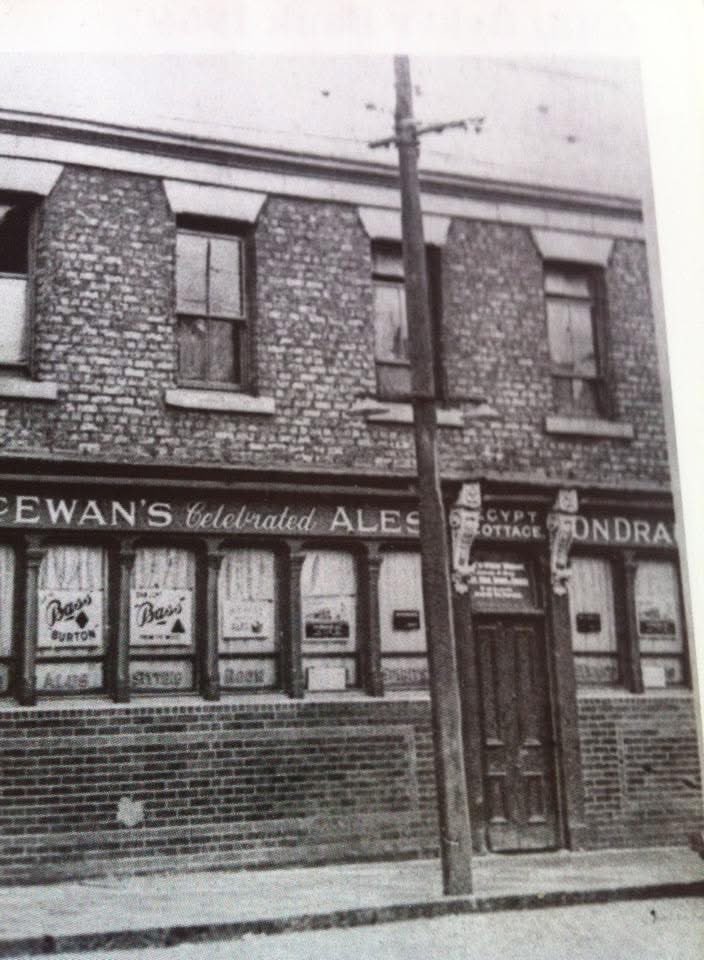
Newcastle
Egypt Cottage
Last Updated:
29 May 2025
Newcastle
This is a
Pub
54.972233, -1.597398
Founded in
Current status is
Redeveloped
Designer (if known):

Replaced by student accomodation
This is the site of what’s possibly Newcastle’s most talked about lost pub.
This was once the home of Egypt Cottage, well known as the stomping ground of a load of telly personalities working at the Tyne Tees studio next door. Of course its history goes much further back than telly.
On the right hand of my shot is where it stood - pretty much the same perspective as the older shot. This was possibly Newcastle’s first licensed house, having been here since the early 18th century in a much different form. It was probably a small cottage, and a notice in the 1840s states it had four rooms with a good cellar and other conveniences. It was a detached building in the 1830s, with two projecting windows on either side as per Wood's Plan of 1827.
The name was coined as this area came to be known as Little Egypt, thanks to the great pyramids of grain which were stored there, and later went on to feature Europe’s largest grain warehouse on the Quayside. As a side note, there’s a reference in newspapers to the Little Egypt in 1797 - a building near St Ann’s Church which “stored immense amounts of foreign corn” imported when domestic supplies were scarce. It did in fact catch on fire, but was extinguished with little damage. It’s fascinating how these names linger, then fade over generations.
The pub we recognise was rebuilt in 1873 in a typical Tyneside style. It became a McEwan’s pub as well as a Scottish & Newcastle, but later became a free house. The cottage became well known for its darts competitions, thankfully after a dramatic fire started by burglars who were after some cash. There were some major adaptations too in 1937 by WM and TR Milburn of Sunderland, with the front facade from this period. The interior was an interesting art deco and Egyptian crossover, with a marble topped bar and art popularised after the discovery of King Tut's tomb in 1922.
And now sadly it’s no more. It gained notoriety as the haunt for visiting celebrities milling around after filming The Tube next door. Last orders came in 2009, and the site is now student accommodation.
Listing Description (if available)


Both of these maps depict Egypt Cottage form the mid to late 19th century. City Road was originally known as the New Road, carving through the east of Newcastle around the 1790s. From the Keelmens Hospital to St Ann's, much of it was industrial as well as supplementary infrastructure for the dense neighbourhoods of Sandgate below and Battle Field. Egypt Cottage stood in front of Egypt Square and near Egypt House, where from the 18th century imports of grain were stood to supplement the towns supplies in times of hardship and bad harvests. Egypt House stood nearby from around 1855 - originally appearing to be bourgeois townhouses but later multiple occupancies.
The 1890s plan provides greater clarity. You may notice the Wesleyan Chapel - not the blue building which stands nearby today. It was named the New Road Mission Room. Sadly though, I haven’t found an exact date for when it was built - it’s been a really tricky one to research. Similar to the mission down the road, this was to spread the Christian principles of John Wesley in a heavily industrialised and impoverished area. Missions were strategically placed where it was felt the grasp of god was declining due to less than ideal living standards, alcohol and depravity.
For some reason it was demolished by the 1910s and replaced with a warehouse & garage. Perhaps there wasn’t enough demand for their service or maybe the Mission just east meant it was redundant. Either way, it was replaced and flattened around WWI. If anyone has any info, I’d be very interested!

Its industrial spine persisted into the middle of the 20th century as shown here. Before becoming the Tyne Tees studios, the whole of Egypt Square was large warehouses supplementing the busy trading port on the riverside below. It's how so many pubs managed to stay alive down here too - the Rose & Crown, Ropers Arms, Sun Inn, Albion Inn and the Barley Mow were all operational within a fairly small distance. The Quayside railway was still in operation for another couple decades after this.

The site of Egypt Cottage and the Tyne Tees TV Studio in May 2025. It is the same angle as the shot below.

The television studios and Egypt Cottage in 1960.
Courtesy of Steve Ellwood and the Jack & Geoff Phillips Photographic Collection

The Egypt Cottage pre-refit in the 20s or 30s. Unknown original source.
